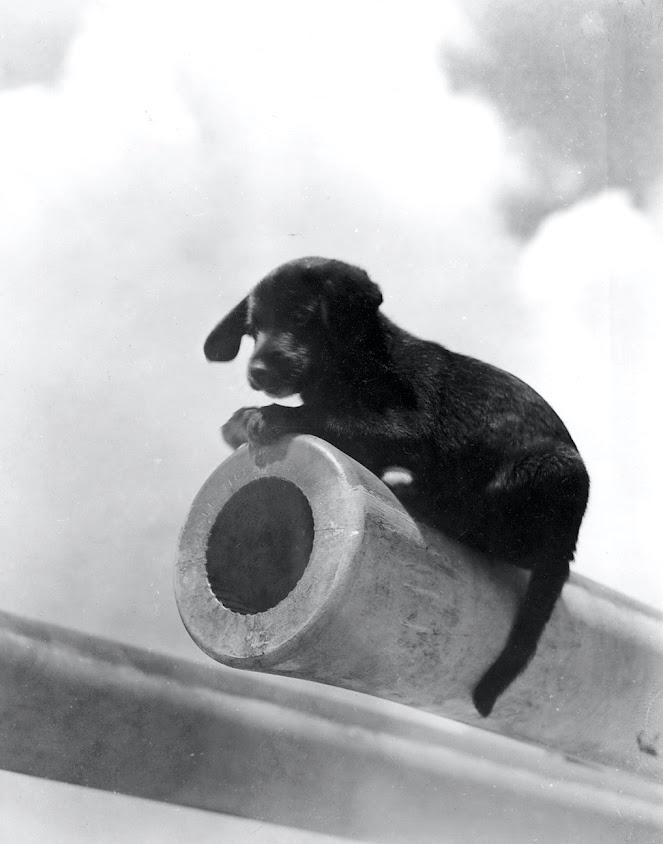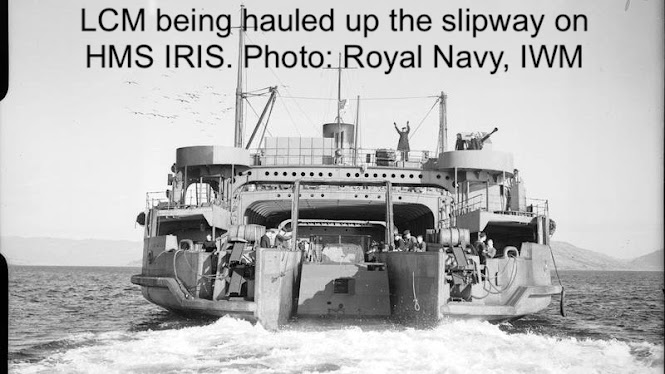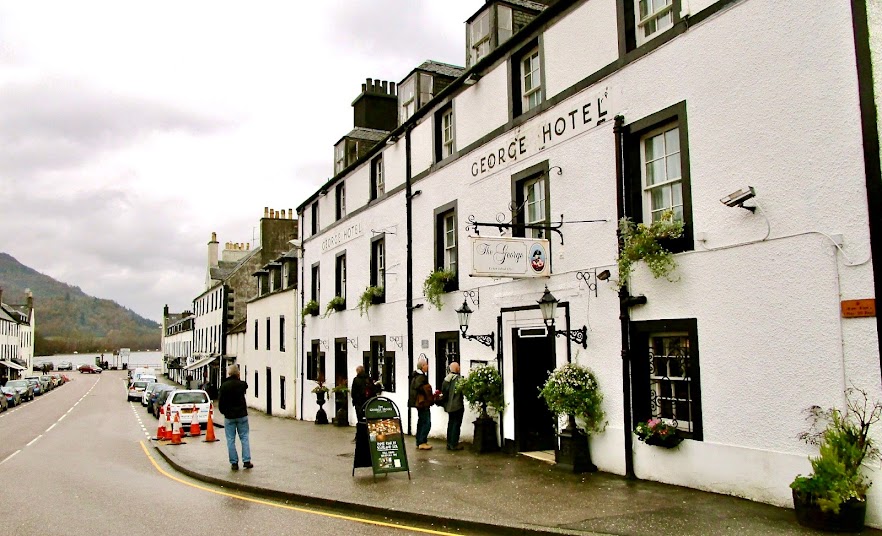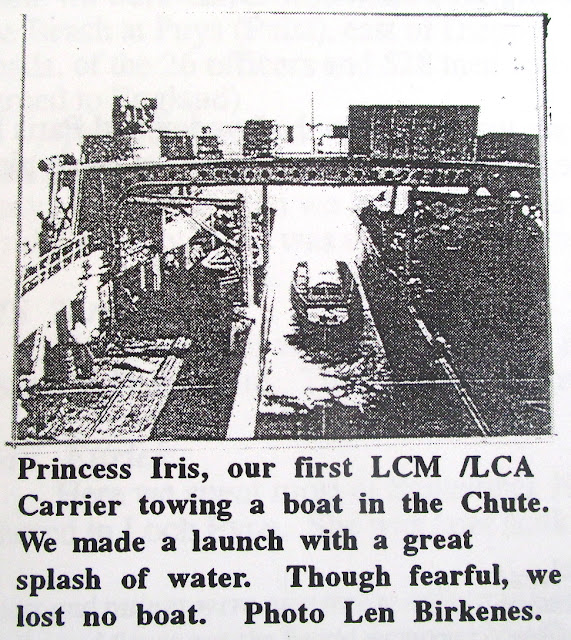There are Pros and Cons re Some Photograph Collections
This Editor's Job is to Find the Silver Lining!
This photo came with no caption... RATS!! The silver lining is... I know
exactly where to find a lengthy caption for this exact picture from 1943.
The photo collection contributed to me a few years ago by Steve Evans, after his father Lloyd Evans (RCNVR/Combined Operations 1941 - 45) of Markham passed away, is rare and very valuable for adding to our knowledge of the roles and responsibilities associated with a relatively small band of Canadian sailors.
The sailors who are the focus of this blog/website were members of RCNVR who also volunteered to serve in Combined Operations from 1941 - 1945, and by so doing manned various types of landing crafts for major raids and operations during World War II, beginning with the Dieppe Raid (August 19, 1942) and thereafter several operations, invasions or D-Days. For example, Operation Torch (Allied invasion of North Africa beginning November 8, 1942), Operation Husky (Sicily, July 10, 1943), Operations Baytown and Avalanche (Italy, Sept. 3 and 9, 1943 respectively), and more.
Lloyd Evans, in my opinion, was a clever and creative man. He played musical instruments (drums and brass instruments from what I can gather), took very good photographs of the birds and squirrels that inhabited is backyard during the later years of his life, and told me he carried a camera in his kit bag for much of the war even though he was not supposed to do so. That many good photographs survived the war is a rare thing - many of Lloyd's mates lost their navy kit bags, possessions and souvenirs from a warehouse in Port Said or Alexandria while taking part in the invasions of Sicily and Italy.
Lloyd Evans, in my opinion, was a clever and creative man. He played musical instruments (drums and brass instruments from what I can gather), took very good photographs of the birds and squirrels that inhabited is backyard during the later years of his life, and told me he carried a camera in his kit bag for much of the war even though he was not supposed to do so. That many good photographs survived the war is a rare thing - many of Lloyd's mates lost their navy kit bags, possessions and souvenirs from a warehouse in Port Said or Alexandria while taking part in the invasions of Sicily and Italy.
That being said, even though Lloyd's photo files do not include captions, or details re locations or dates, we can still learn much from Mr. Evans' photos and memoirs and others that are very closely related.
Below readers will find a number of black and whites from Lloyd's collection and offerings and links to other material that relates to the roles and adventures of the 950 - 1,000 Canadian sailors who were part of Combined Operations during WWII.
PHOTO GALLERY -
Lloyd circled Africa by ship during the summer of 1943 on his way to take part in Operation Husky. Stops for refueling were made at major ports and Canadian sailors were granted time ashore. No names, ranks (officers or ratings?), location, date appear with this photo. But a somewhat similar photo follows...
Possibly in Capetown, Durban, Port Said, Alexandria, Cairo. June - July 1943.
Canadians in Combined Ops in Cairo, June - July 1943
Ted Zealley (back row, above) appears again below:
From another photo collection (by Joe Spencer, RCNVR and Combined Operations 1941 - 45) we see more Canadian sailors (identified in caption) in Ismalia, Egypt, 1943:
From L - R: P. Martel, Ed Chambers, S. Ingram, Norm Mitchinson
Ed Chambers later served on Vancouver Island w Joe Spencer and
my father Doug Harrison, from Jan. 1944 - Sept. 1945 (dispatched)
Another no-name photo, but I will guess these Canadians in Combined Ops are on their way to Sicily. By bicycle?? No, on leave in Cairo or Alexandria:
The 2nd cyclist (left side, above) looks familiar, even in this poor shot
I am guessing the second cyclist from the left is C. Michael above.
My father, 'Author (Doug) Harrison' "rides a Gharry" in Capetown,
1943, on his way to Sicily. Not as fast as a bicycle, I bet!
Lloyd Evans provides photographs of his Naval Pay and Identity Book. Some details within may be of interest to readers, especially if a close relative was in Combined Operations:
Members of the armed forces loved getting letters from home. Below is a guide for them to follow when sending mail back home:
Rates of Daily Pay below is confusing. Help Wanted from readers:
HMS Monck is stamped on a page below and it may have something to do with Lloyd getting some clothing (shirts?) in preparation for an upcoming trip around Africa. There is a link to Combined Ops.
General view of HMS MONCK, showing hangars and craft.
Photo Credit - © IWM (A 29940)
As well, on the second page below we see a stamp re Liverpool, March 24, 1943. This is prior to Lloyd's journey to Sicily and there appears to be a record re 'inoculation' completed in Cape Town in May, i.e., during the actual voyage to Cairo and Alexandria (to prepare for voyage w landing crafts to Sicily).
Lloyd provides a few details about the above time period in memoirs:
The last port of call before my next mission (Sicily, July 1943) was Liverpool. My cousin Ashley's new ship was in port in Canada Docks so I paid him a visit and we had a night out on the town together. [Photos of Ashley were shared in the previous post, i.e., Photographs: From Collection of Lloyd Evans (2)]
During our short stay in Liverpool we were given more shots in the arm for tropical diseases so we knew something was in the offing. About seventeen or so of us ratings and one sub-lieutenant were then sent to the British merchant ship MV Pardo along with our landing craft... the convoy was set up and around March or April we sailed for parts unknown. My Navy Chronicles, page 17
In relation to the same time period, i.e., March - May 1943, my father writes the following in his navy memoirs:
We formed up and headed to sea again, this time from Liverpool. We didn’t know but Sicily was next. The Silver Walnut left convoy at Cape Town, South Africa to coal up and for repairs. She was constantly breaking down and was a sitting duck for subs. Fortunately, there were not many subs in S. Africa vicinity.
While aboard the Silver Walnut I struck up an acquaintance with a Scottish engine room engineer named Hastings, age about 55 - 60, with lots of money. Every morning for awhile he would wake me up early and say, “Are you for a halfer, Douger?” I’d say yes and go up to his cabin for a big hooker of whiskey. Our captain caught on and stopped it. How thankful I am now.
Canadians in 80th Flotilla on the Walnut, prior to sailing for Sicily, April 1943
D. Harrison sits in back row (middle), left of PO Freddie Logsdon (black cap)
Lloyd received some cash (likely British Pounds), as recorded below, on October 20 and Nov. 5, 1943, after returning to England from Italy and the Mediterranean Sea:
Several pictures of the following gentleman appear in Lloyd's photo files. No name or rank is supplied. However, Lloyd mentions the following about his time in Sicily:
Despite the chaos of war chance meetings with friends and acquaintances happened from time to time. One day I visited the airfield (i.e., "a nearby grass runway, a Canadian Spitfire squadron") and ran into Flight Lt. Bob Hazel, who used to play football for the Ottawa Technical High School I attended a year or two earlier. We had dinner and a few drinks together and I slept that night in the squadron ambulance. My Naval Chronicles, page 29.
Help wanted. Is the plane below a Spitfire? I don't think so!
Lloyd Evans appears fifth from the right. Location - Ottawa, Canada.
One of many convoys Lloyd saw during his journeys. On his way to Sicily?
The photo below was in Lloyd's files without explanatory details. By chance, however, I am familiar with it, knowing that it appears in the first of a two-volume set of books (from my father's collection) entitled St. Nazaire to Singapore: The Canadian Amphibious War 1941 - 1945, a compilation of stories written by veterans of RCNVR and Combined Operations, produced by David and Catherine Lewis and Len Birkenes. Lloyd's photo is higher quality than in Volume 1 of the set, but I have added the caption:
Location: HMS or Camp Saunders, Egypt. Photo from Volume 1, page 194
Canadians in Combined Ops at HMS Saunders, Egypt, prior to invasion
of Sicily, July 1943. I recognize a few faces but no list provided. GH
Photo found at Lloyd's memoirs @ combinedops.com
The links to the two books are provided below, as found at the University of Alberta:
assault landing craft tied down to their left. June - July, 1943
The sailor with Lloyd (above) may be included in the trio below, i.e., first on the left. The other two are not identified but the sailor on the right looks a bit like a fellow I have seen in photo files belonging to Joe Spencer (RCNVR, Combined Operations) and one other photo I found in The Winnipeg Tribune while doing some research re microfiche.
Same person as fellow in previous photo? Not sure.
But I am sure about the next one being the same Jack Trevor as above:
Photo as found in The Winnipeg Tribune, microfiche at U.W.O.
I am pretty sure that this next photo was taken in Halifax at a park (east of Citadel National Historic Site) called Grand Parade, with significant war memorials. I think the sailor is Clayton Marks, seen in an earlier photo (repeated below).
Clayton Marks is in back row, below, first on the left. You may disagree with me re his identity above. His daughter did, but I'm sticking to my guns ; ) Clayton wrote a fine book re the role/responsibilities of Canadians in Combined Operations.
His book has been reprinted and is available for sale on this site. Many fine passages from Mr. Mark's book can be found on this site as well. For example, link to Memoirs re Combined Operations: Dieppe by Al Kirby
The original text (upper left) has been updated. GH
C. Marks - for certain - is front and centre in the next photo re navy reunion:
L - R: Ed Corbett, NA, Clayton 'Red' Marks, NA, Jake Koyl*
Jake Koyl appeared in an earlier photo @ HMS Saunders
Lloyd and others enjoyed time with four-legged mascots during long times aboard ships at sea.
He wrote a story re one such mascot in memoirs. Furry, four-legged, and frightened... but not a dog.
My Naval Chronicles, pages 17 - 18
The next photo (source unknown) may have reminded Lloyd of his time in hospital and what he saw there:
In Lloyd's memoirs we read the following re his hospital stay during the invasion of Italy:
I didn’t think my leg was too bad other than very sore but it got worse a few days later. After a visit to the first aid post, I was sent down the coast by ambulance with a few others. We spent one night in a church and next day arrived at a British hospital in Catania near Mt Etna. When they noticed my Canada badge, I was offered a move to a Canadian base a short distance away - the 5th Canadian Casualty Clearing Station that was situated in a modern Sicilian hospital. The next day they operated on my leg to remove a blood clot.
My Naval Chronicles, pages 33 - 34
The officer below comes with no name but I believe he appears in a Canadian photographer's book:
Lloyd may have collected the photo because of the cute mascot! GH
Is the officer below the same one?
From H.M.C.S. One Photographer's impressions, G. A. Milne, page 81
The final photo may have been collected by Lloyd because it reminded him of his return to Canada in January 1944:
More photos from the collection of Lloyd Evans will follow.
Lloyd at home in Markham, Ontario
Unattributed Photos GH









































































